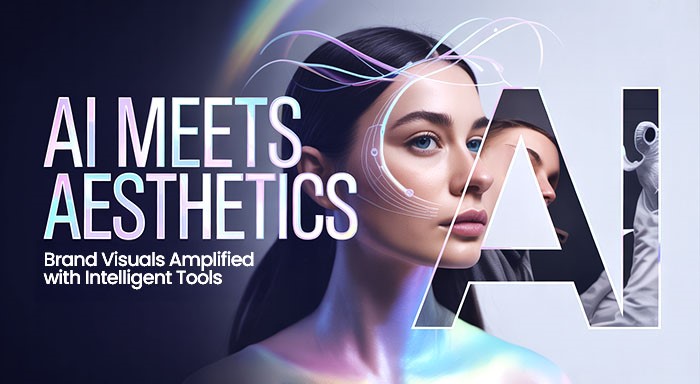Since the first impression of a brand is increasingly becoming visual, aesthetics are no longer merely a matter of taste but strategically crucial. Whether it is for social media updates or website headers, digital advertisements or packaging, the visual voice of a brand is going to directly impact how users perceive that brand.
It is only recently, however, that the creation, maintenance, and fine-tuning of such images have required a high degree of artistic acumen, plus plenty of time and money. Welcome to the age of AI design tools, where creative implementation meets automation and intellectual redundancy. The coming together of visual branding and artificial intelligence is creating a new electronic landscape. As sharper tools that can analyze, edit, and even design visual material surfaces, brands can keep their appearance sleek, unified, and form-stick—without spending an ounce of their time or cash.
The Aesthetic Imperative
In a noisy online marketplace, attention is a valuable commodity. It takes users just 0.05 seconds to decide what they think of a site or ad, research says. That initial impression is largely visual. Clean, professional design elements don’t simply attract attention; they signal credibility, quality, and value. Companies that invest in high-end visuals obviously have a benefit over others who don’t.
But it is not as simple to make all platforms visually coherent. For small development companies or even individual entrepreneurs, for example, hiring a full-time designer or establishing large creative teams is practically not an option. That is where clever AI tools come in to bridge the gap.
AI as a Creative Collaborator
AI isn’t designed to replace designers—it’s designed to enhance them. Consider it like a digital partner that can handle millions of pixels in mere seconds, realize patterns in thousands of images, and assist in applying style changes or enhancements at scale.
Artificial intelligence-powered tools can now accomplish everything from:
- Automatically enhancing images and video for color correction and clarity
- Recognizing and swapping out distracting items or backgrounds
- Generating new image from text descriptions or reference images
- Creating dynamic motion graphics from static inputs
- Rendering style suggestions based on brand guidelines or industry standards
Among the first to lead this new category is Remaker AI, a fresh platform that enables users to remaster and enhance images using simple, intuitive controls with powerful machine learning. From revitalizing product images, tweaking tone for holiday promotions, or repurposing content across platforms, tools like Remaker AI produce pro-level results without the typical production hassle.
Enhancing Brand Consistency
Visual consistency is the core of branding. Your customer needs to be able to recognize your brand at first glance, whether on Instagram or your website. AI makes it possible by maintaining consistency through:
- Template-based editing: Smart tools can read your brand’s color scheme, typography, logo usage, and image style preferences. Once trained, they make sure every asset follows these guidelines.
- Batch processing: Need to reformat or resize 100 images to be used on multiple platforms? AI tools handle it easily, while ensuring quality and style remains the same across all.
- Style transfer and replication: Need a campaign look you love? AI can replicate that across different visuals and save time while keeping things consistent.
With the automating of the drudgery work, creative groups will be left with more time to focus on storytelling and ideation—leaving machines to handle the tedious, repetitive production.
Video and Motion: The Future AI Frontier
Frozen moments are just half the image. With video content dominating platforms such as TikTok, YouTube, and Instagram Reels, brands are increasingly considering how AI can help with video editing, motion design, and animation.
Artificial intelligence programs now have the capability of editing raw footage, applying transitions, harmonizing visual components with music, and even generating avatars or animation cycles. This lowers the bar for producing engaging video content that aligns with a brand’s visual voice.
For example, an e-commerce company can use a tool like Remaker AI for automatically applying motion effects to static product photos, making lifestyle montages, or styling content for a certain theme or season, without the assistance of a production team.
AI and Democratization of Design
Perhaps the most groundbreaking aspect of smart visual tools is that they are so accessible. You don’t need to be a Photoshop master or have decades of experience as a designer in order to craft stunning brand images. Entrepreneurs, marketers, content creators, and small business owners can now produce content on par with agencies—straight from their browser.
This democratization of design is particularly potent in the emerging markets, where there has long been a scarcity of access to creative resources. AI makes levels equal, allowing more voices to add to the visual culture of branding and marketing.
Ethical and Creative Considerations
The more advanced AI technology, the more it requires responsible application. Though it may be attractive to automate everything, it’s crucial to keep some human touch in the brand narrative. Images still have to reflect true values, real individuals, and true experiences.
Besides, AI needs to be considered as a co-creator rather than a replacement. Smart tools need to enable human creativity, and not make it monotonous. With good brand guidelines and clear creative direction, companies can use the effectiveness of AI without sacrificing anything in terms of originality.
Looking Ahead
The future of visual brand identity is collaboration—machine and human. And as artificial intelligence continues to evolve, it will become more intuitive, more attuned to brand identity, and more integrated into the design process.
Platforms like Remaker AI are just the beginning. The ability to transform mundane imagery into exceptional experiences, on the fly and at low expense, will change how brands connect with their publics. And in a world where looks can make or destroy that connection, the smart use of AI could be the most beautiful move of all.
Conclusion
Brand imagery has always been a marketing mainstay, but today in this digital age, it’s also the battlefield for attention. Smart design software powered by artificial intelligence is giving businesses an advantage—not through replacing creative thinking, but through enhancing it. From image enhancement and style automation to coalesced visual storytelling, Remaker AI-type platforms are allowing brands not only to look better, but to think larger, create quicker, and connect deeper.






